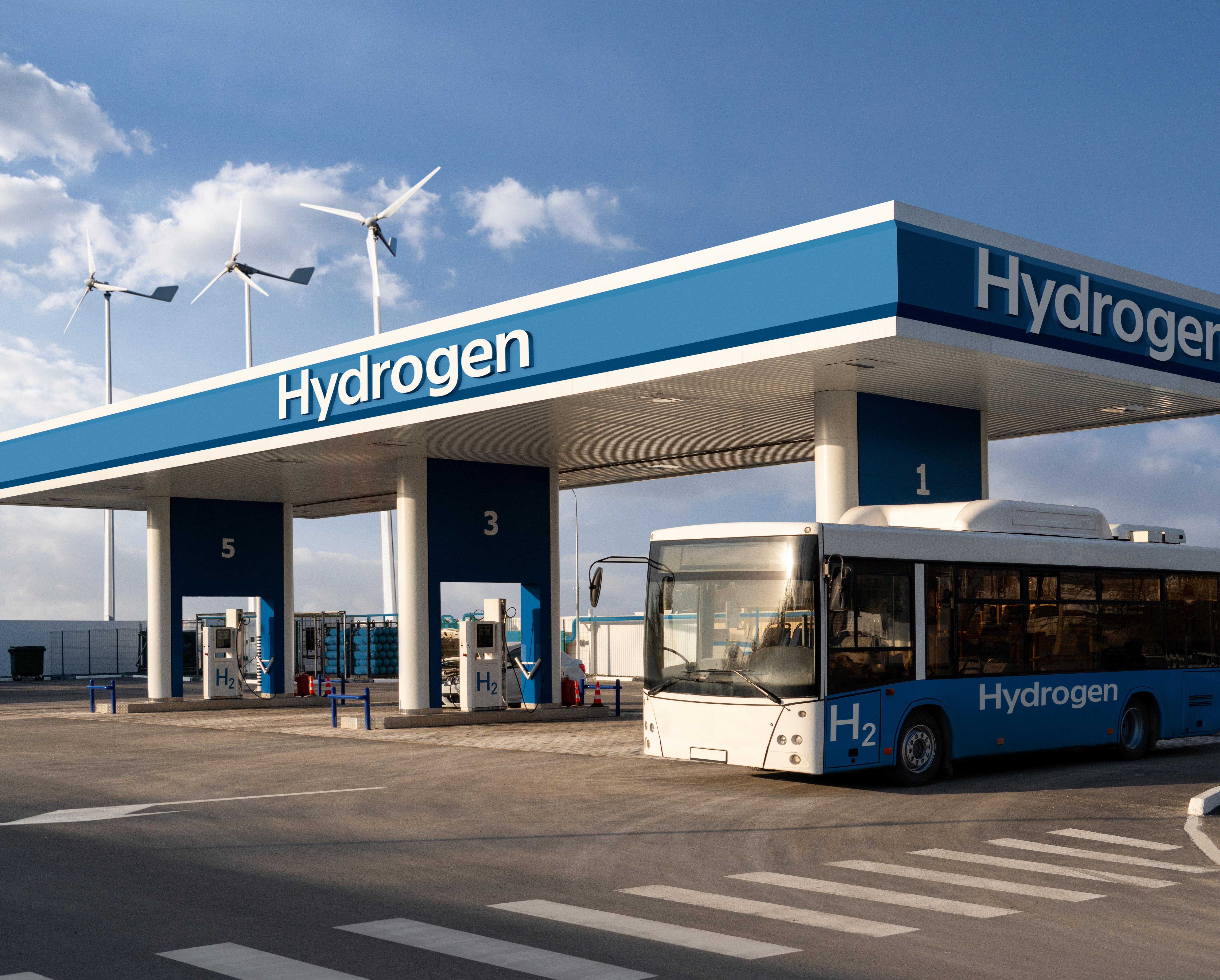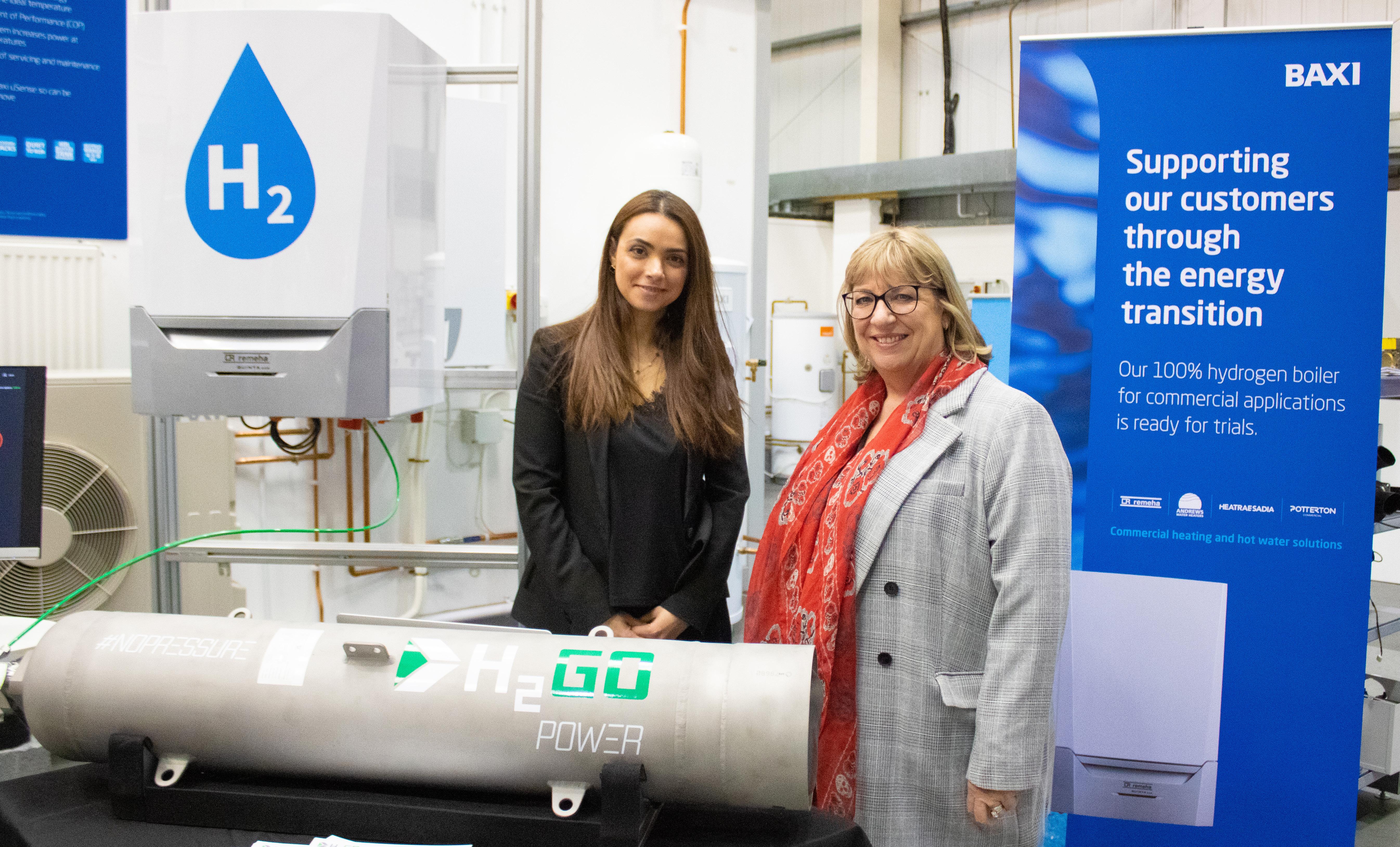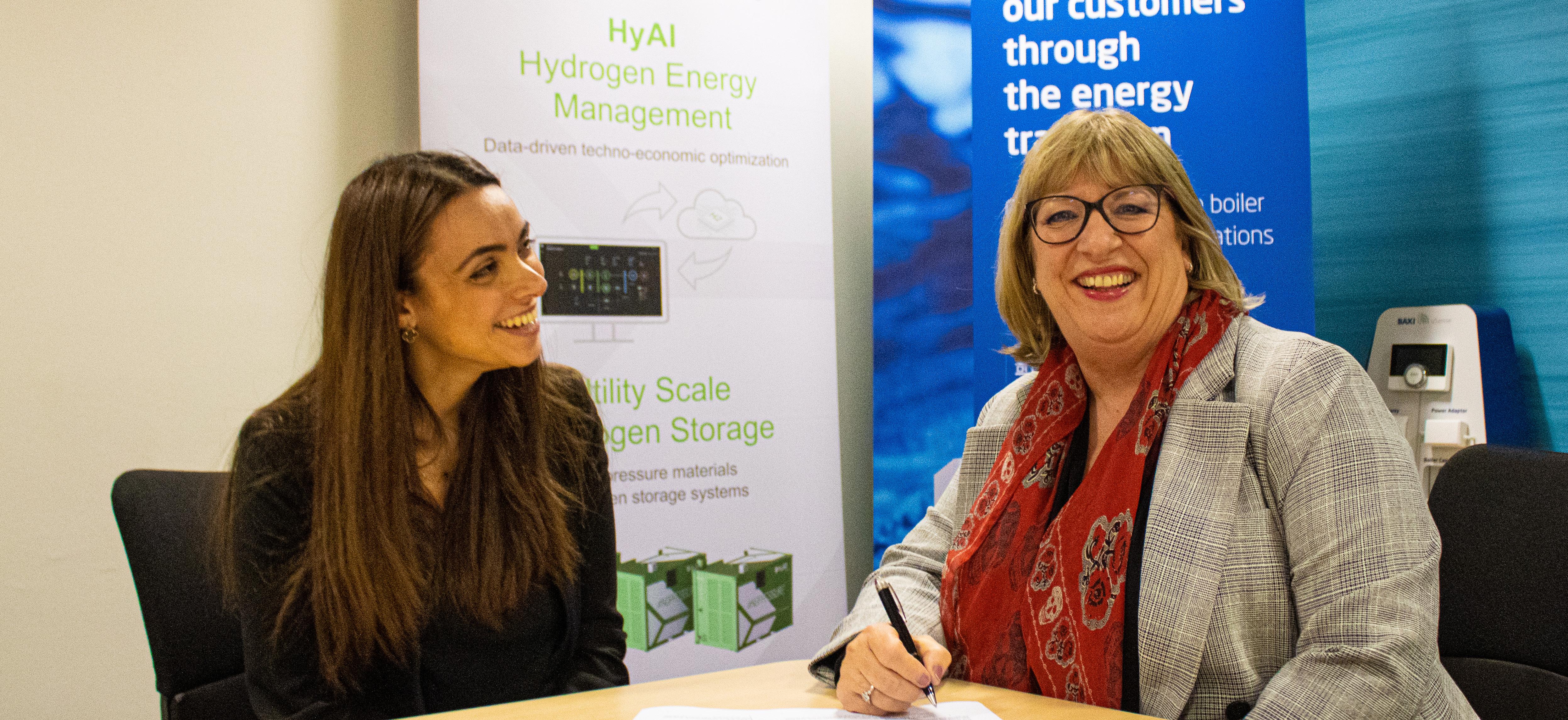Hydrogen Industry Leaders e-magazine March
UK HYDROGEN CERTIFICATION: UNLOCKING THE NET ZERO ROADMAP
P / 10

Hydrogen Industry Leaders e-magazine March
P / 10
P / 10
UK Hydrogen Certification: Unveiling the Net Zero Roadmap
P / 04
What are the Key Drivers and Challenges for Green Hydrogen Adoption?
P / 06
Development of Hydrogen Supply Chain Hinges on Major Policy Changes
P / 08
This Partnership Will use the World’s First Pure Commercial Hydrogen Boiler
P / 10
UK Hydrogen Certification: Unveiling the Net Zero Roadmap

P / 16
International Projects
P / 14
New EU Definitions for Renewable Hydrogen: Here to Stay?
P / 12
Collaborative Working Between Nations Set to Increase
P / 14
New EU Definitions for Renewable Hydrogen: Here to Stay?


P / 16
International Projects
P / 19
Previous Editions
P / 20
HIL London Next Up


This could become the turning point for successful hydrogen policies.


After the latest IDTechEx report discussing the key drivers and challenges for green hydrogen adoption and hydrogen cost analysis was released, the sector looks to be on the tipping point of breaking through into the UK market.
Highlighting the key drivers and challenges for green hydrogen adoption has always been theorised and discussed within the sector, but this report began by articulating this debate in greater depth.
Speaking to Principal Technology Analyst Dr Alex Holland, Hydrogen Industry Leaders heard: “Decarbonisation and energy security are the primary drivers behind the adoption of green hydrogen. In Europe, the over-reliance on Russian natural gas has had well-reported economic impacts on the region, and the European Commission’s RePowerEU strategy, which included targets for hydrogen production and import, had the explicit goal of reducing reliance on Russian gas.”
The forecast for the electrolyser market in the UK is a good benchmark for assessing the future of hydrogen production, as technology plays an integral role in hydrogen production. The report delved into this but began by outlining the context of electrolyser technologies.
Technology use will evolve over the next decade
Each technology comes with its own set of advantages and disadvantages. Alkaline electrolysers have long been commercial and used for industrial applications. They are characterised by their low capital costs and long lifetimes.
PEM electrolysers are at an earlier stage of commercialisation but are set to gain market share over the coming years. They are characterised by higher power densities, output hydrogen pressures and faster response times than alkaline systems. This generally makes them better suited to utilising renewable power. SOELs are the youngest electrolyser technology.
Operating at elevated temperatures above 700°C, they offer higher system efficiencies but are expensive, can struggle with the dynamic operation, and improvements to system lifetime are likely to be necessary.
Dr Alex Holland Principal Technology Analyst IDTechExBeyond this, hydrogen can play an important role in decarbonising some important and hard-toabate sectors, including the refining and ammonia production industries.
Further IDTechEx analysis shows that European companies are particularly active in their plans to expand and grow their electrolyser manufacturing capacities and capabilities, though significant investment into electrolyser manufacturing is also expected from Chinese and US companies, while Indian and Australian players are also looking to enter the market. The electrolyser market is currently dominated by alkaline and PEM electrolyser manufacturers, with comparatively few companies manufacturing or commercialising solidoxide electrolysers. However, the similarity between solid-oxide electrolysers and solid-oxide fuel cells could provide an entry point for fuel cell manufacturers into the green hydrogen market.
Certainly, growth in the electrolyser market across the three electrolyser types will be needed to meet ambitious national and regional targets for green and clean hydrogen production.
Expanding on these predictions, Alex said: “In the short term, we see alkaline electrolysers being the most widely deployed technology due to their lowcost, but PEM electrolysers are gaining popularity as they are better suited to being coupled with renewable energy sources.”
Focussing on costs in more detail, part of the report broke down the shape of green hydrogen cost analysis, how it will likely shape up over the next decade and what can be implemented by the public and private sectors to improve this situation.

“The cost/price of electricity is the most important factor that determines whether green hydrogen can be produced at a cost competitive with grey or blue hydrogen. Improvements to electrolyser efficiency and their ability to follow the output from renewable power sources will also be important in helping green hydrogen become cost competitive.”
“Of course, there may be some premium that can be placed on green hydrogen, not just because of its environmental credentials, but also as a hedge against potential volatility in natural gas supply and price.”
Naturally, when discussing future markets, there is a discussion about the alignment of public and private investment.
Alex rounded up the interview by explaining: “Subsidies, credits, carbon taxes, can all be used to help increase the adoption of green hydrogen. Support for industrial users to adopt hydrogen could also de-risk early-stage projects. More broadly, there is also a need to install high levels of renewable energy to bring costs down and ensure the hydrogen produced via electrolysis is actually low-carbon.”
Dr Alex Holland Principal Technology Analyst IDTechExA decrease in the capital cost of electrolyser systems is also expected as technology improvements are made and manufacturing scale and experience are achieved.
Following last month’s hydrogen week, the EIC has released their response to the hydrogen buzz and what to specifically guard against, including the importance of introducing a more substantial policy.
The development of a robust hydrogen industry that helps to achieve net zero targets in the UK and elsewhere hinges on significant policy changes that tackle issues related to hydrogen infrastructure, supply and demand dynamics, and financing needs, according to the Energy Industries Council, the world’s leading energyagnostic trade association.
Speaking on the occasion of the UK’s first official Hydrogen Week, EIC Chief Executive Officer Stuart Broadley said: “The UK is among the world’s top countries in hydrogen with a robust supply chain active in manufacturing, development and beyond, but more needs to be done to build a longstanding, healthy hydrogen supply chain.”
As of Q4 2022, the UK had 52 hydrogen production projects in planning or development, worth over USD$13.7 billion, EICDataStream shows. The UK is also home to some of the world’s major electrolysers manufacturing facilities, with ITM Power already producing 1000 units a year and planning to ramp up production to 5000.
“The industry needs supply-demand equilibrium to thrive and contribute to national and global environmental commitments,” Stuart said. “Our research and industry conversations show that the global supply of hydrogen could exceed demand. If this trend continues, there is a risk that producers will have no buyers, risking a massive drop in H2 prices and long-term disruptions to the supply chain.”
We need to create demand opportunities immediately at industrial and retail levels. One way to do that is to give consumers a choice for hydrogen-fired vehicles by opening up hydrogen refuelling stations across the UK.
Stuart Broadley Chief Executive Officer EICAdditionally, the sector needs to secure funding to support hydrogen research and development efforts and the deployment of hydrogen production and distribution infrastructure.
By prioritising the development of UK content in hydrogen projects, the government can support the growth of local businesses, create jobs, build skills, and ensure that the UK is at the forefront of this rapidly evolving industry.
The EU is also in keen discussion around hydrogen and what constitutes green hydrogen. The UK are also hot on the heels of European policy, with the consultation on the low-carbon certification scheme being announced alongside the European Commissions system that permits hydrogen produced from electrical grids that contain significant amounts of nuclear electricity to be categorised as green. This is only permitted if the producer has a long-term contract for renewable energy proportionate to its use.
Organised by the North West Hydrogen Alliance (NWHA), it is an effort to bring the UK’s regions together in order to cement the country’s position as a world leader in hydrogen and capitalise on the enormous opportunity the sector offers for both reducing carbon emissions and driving green economic growth.
“To reach the planned 1.3 million metric tonnes or 10 gigawatts of hydrogen production capacity by 2030, the government needs to decide on the Track 2 industrial carbon capture and storage clusters and draw solid plans to achieve this target,” said Rebecca Groundwater, EIC’s Head of External Affairs.
Private sector still waiting to be incentivised
“To encourage businesses and investors to invest in hydrogen projects, we need a clear plan with deadlines. We also need to classify hydrogen internal combustion engine as a zero-emission powertrain (as the EU and other regions are doing) and support for hydrogen refuelling stations infrastructure to drive private investment.”

Many UK-based members of the EIC are active in hydrogen, delivering their services and expertise domestically and globally. EIC comprehensive databases provide critical data on hydrogen projects in the UK and around the globe as well as information on hydrogen suppliers, as part of EICSupplyMap.
EIC has also recently released the Hydrogen EIC Insight Report, which tracks hydrogen projects around the globe and provides in-depth analyses of the current state and future developments of the hydrogen industry.
Professor Joe Howe, Chair of the NWHA and Executive Director the Energy Research Institute at the University of Chester, said: “The last few years have seen hydrogen rising in prominence in the net zero agenda. It’s now recognised as critical to delivering on our decarbonisation targets. While several regions are already delivering on hydrogen projects, if we really want to capitalise on this huge opportunity, the UK needs to collaborate.”
EIC is a leading trade association for the energy industry, with a global membership of over 800 companies that cover the entire supply chain in oil and gas, power, nuclear, and renewables.
Founded in 1943, EIC promotes the interest of its members by working closely with governments and key stakeholders.
After a partnership to use the world’s first pure commercial hydrogen boiler to deliver innovative hydrogen storage technology was agreed upon, Hydrogen Industry Leaders highlights what this could mean for the retrofit programmes in the UK.
Heating and hot water solutions provider Baxi and H2GO Power, hydrogenbased software and hardware solutions innovators, have signed a Memorandum of Understanding (MoU) formalising their commitment to developing innovative green hydrogen-based technology that will tackle both heat decarbonisation and energy reliability.

The MoU was signed by Baxi’s MD Karen Boswell and Enass Abo-Hamed, H2GO’s CEO, at a presentation of their carbon-
neutral heat-in-a-box system held at Baxi’s Dartford Training Centre.
The partnership includes an upcoming industrial scale trial of this unique containerised pre-heating solution which will be hosted by Northern Gas Networks (NGN) at its Low Thornley test facility.
Pre-heating is an essential part of distributing gas. Before it can be transported to homes and businesses through the network, the pressure of the gas must be reduced. This process can cause it to freeze, so pre-heating takes place to allow the gas to flow. Traditional pre-heating units are highly energy and cost intensive. Heat-in-the-box will lower
the cost of pre-heating, while delivering the supply at much lower costs for applications at a massive scale.
This partnership will deliver the world’s first commercial pure hydrogen boiler that will provide customers with greater flexibility in meeting their emissions reduction targets
Karen Boswell Managing Director Baxi UK & IrelandThe aim of the trial is to demonstrate how the heat-in-a-box system can supply heat for gas pre-heating in a safe and carbon-neutral manner, with the potential to supply renewable heating for other operations.
Heat-in-a-box methods may maximise self-generated renewable electricity
Heat-in-a-box combines electrolysis, hydrogen storage technology and Baxi’s hydrogen boiler, the first-ever pure hydrogen boiler for commercial applications. The end-to-end system will be powered by solar photovoltaics and supported by an AI-enabled optimisation software platform.
As heat-in-a-box can help maximise selfgenerated renewable electricity, it offers an interesting solution for multiple use cases – including decarbonising heat in off gas grid non-domestic buildings.
Karen Boswell, Managing Director at Baxi UK & Ireland, said: “This partnership will deliver the world’s first commercial pure hydrogen boiler that will provide customers with greater flexibility in meeting their emissions reduction targets. Innovation projects like this are critical to understanding the role hydrogen can play in helping to decarbonise a range of sectors –including the difficult ones like heat.”
Dr Enass Abo-Hamed, H2GO Power CEO, said: “We are pleased to be part of this world-first initiative. Today’s demonstration is a significant step as we explore the opportunities that could be unlocked through Heat-in-the box. Demand for heat is three times higher than the demand for power, while responsible for 40 percent of all global emissions. And we are determined to deliver a carbon neutral solution without compromising on cost and productivity to be used across key industries including as ceramics, glass, cement, food and beverage and chemicals.”

The case that hydrogen can support the decarbonisation of the UK economy, particularly in ‘hard to electrify’ industrial sectors, and provide greener, more flexible energy across power, transport, and potentially heat has already been accepted.
Likewise, the idea that hydrogen produced in the UK could also create thousands of jobs across the country and provide greater domestic energy security, lowering our reliance on energy imports, is widely acknowledged.
In order to capitalise on this potential, it is essential that an in-depth, detailed certification scheme is in place. In response to industry calls for a consultation for a low-carbon hydrogen certification scheme, BESS committed to launching a hydrogen certification scheme by 2025 to demonstrate high-grade British hydrogen for export and ensure any imported hydrogen meets the same high standards that UK companies expect.
A low-carbon hydrogen certification scheme could benefit the whole hydrogen value chain, including producers, off-takers and society, while supporting the decarbonisation of the hydrogen economy.

The certification scheme aims to enable both the hydrogen and the low-carbon attributes of hydrogen to be exported through compatibility with a range of international certification schemes, allowing exporters to demonstrate their emissions credentials internationally. Similarly, the certification scheme aims to provide the opportunity to certify the emissions of 1 Subject to affordability and value for money.
Creating a trusted, transparent guarantee of origin will help to deliver these carbon reductions by boosting the growth of the low-carbon hydrogen market, helping consumers choose low-carbon hydrogen and moving towards the UK’s net zero targets.
The scheme’s overall objective is to support the decarbonisation of the hydrogen economy. To this end, it should align with the UK’s net zero objectives. It should also minimise any risk of greenwashing and encourage decarbonisation through compatibility with other domestic decarbonisation schemes to generate synergies.
This is best achieved by making sure that there is a clear link between producers and end users of low-carbon hydrogen. With the aim to support this objective, the following priority design features have been set out in a hierarchical approach as, in some instances, design features may need to be traded against one another.
This consultation is separated into sections covering the following areas:
This chapter highlights the basic building blocks for the scheme. The Government also set out their ‘minded to’ position for the unit that certificates should be issued, identify the need to consider how to issue certificates with an evolving standard, and set out how to expect the scheme will interact with the UK Emissions Trading Scheme.
This chapter discusses what information should be contained on a certificate. We set out the certificate design of some international schemes and then set out our ‘minded to’ position that a certificate should include both factual information and a label to help interpret that information.

This chapter sets out how certificates should allow hydrogen to be traced through the value chain. Here we set out our ‘minded to’ position that a Mass Balance system of Chain of Custody is most appropriate for this scheme.
This chapter sets out issues that are likely to require further consideration as we develop the scheme. These issues include how we could structure our consignment approach, how we can enable international trade of certificates, and challenges arising from the mid-stream.
This chapter talks about how the scheme could be delivered, including data reporting and frequency, alignment with other schemes, the transfer and retirement of certificates, and how the scheme could be delivered.

Collaborative working between nations will help secure a global network of hydrogen producers and distributors.
With this in mind, Innovate UK, part of UK Research and Innovation, will work with the Korea Institute for Advancement of Technology (KIAT) and Korean Energy Technology Evaluation and Planning (KETEP) to invest up to £2 million in innovation projects.
The aim of this competition is to fund business-led, collaborative research and development (CR&D) projects focused on industrial research. This is for innovative proposals developed between the UK and South Korea.
Your proposal must include at least one partner from the UK and one partner from South Korea. UK-registered organisations must apply to and will be funded by Innovate UK.
Your South Korean partner will not receive any funding from Innovate UK. South Korean partners must apply to and will be funded by either KIAT or KETEP, depending on the focus sector of the project. For hydrogen, it will need to be through KETEP.
In applying to this competition, you are entering into a competitive process. This competition closes at 11 am UK time on 7 June 2023.
Your project must meet the following criteria:
• Have a maximum grant funding request of no more than £500,000
• Start by 1 November 2023
• End by 30 October 2026
• Last between 24 and 36 months
UK project partners must carry out the majority of their project work in the UK and intend to exploit the results from or in the UK.
The consortium must include at least one business registered in South Korea that is a separate, non-linked entity. Your South Korean partner will not receive any of this UK competition funding. South Korean partners will be funded by either KIAT or KETEP.
All businesses in a consortium must be separate legal and non-linked entities. This is to ensure that projects encourage genuine international collaboration, not internal company research. Linked companies are considered a single entity under the parent company. Projects should have a balanced contribution of the total eligible project costs among the partners from the participating partner countries. No more than 70% of the total project costs can be claimed by any single partner or by all partners from a single participating country.
Each UK partner organisation must be invited into the Innovation Funding Service by the lead to collaborate on a project.
Once accepted, partners will be asked to log in or create an account and enter their own project costs into the Innovation Funding Service.
South Korean partners must not be invited into Innovate UK’s application for the Innovation Funding Service.
If collaborating with other UK-registered organisations, the lead and at least one other organisation must apply for funding when entering their costs into the application.
Subcontractors are allowed in this competition, but they are limited to no more than 20% of the total eligible costs of UK participation.
Subcontractors can be from anywhere in the UK, and you must select them through your usual procurement process.
A UK-registered business can lead on one application but can be included as a collaborator in a further two applications. If a UK-registered business is not leading any application, it can collaborate with up to 3 applications.

A UK-registered academic institution or RTO can collaborate on any number of applications.
Your project must demonstrate the following:
• A clear game-changing or disruptive innovative idea leading to new products, processes or services
• A strong and deliverable business plan that addresses and documents market potential and needs
• Good value for money, which will always be a consideration in Innovate UK funding decisions
• Evidence-based plan to deliver significant economic impact, return on investment (ROI) and growth through commercialisation as soon as possible after project completion
• Considerable potential to significantly benefit the UK economy or national productivity
• The benefits of participants from the countries working together and how this adds value
• A clear definition of where intellectual property (IP) can be used and shared between the participants and countries
• A clear route to market within 2 to 3 years of project completion
Sending ripples through the renewable sector, the European Commission has recently proposed specific rules for the definition of renewable hydrogen, receiving mixed responses from those working in the sector.
In early February 2023, the European Commission set out proposals for two Delegated Acts under the Renewable Energy Directive, both aimed to set out a standard definition for renewable hydrogen in the EU.
Coming as part of a wider regulatory framework for the EU to follow, there has been a big push for RFNBOs to be produced from renewable electricity. Once established, those working in the non-biological origin sector of renewables will have more certainty and investment.
Pressure for regulatory frameworks has been growing in recent months as the EU members strive to meet REPowerEU goals which have laid plans to produce 10 million tonnes of renewable hydrogen by 2030.
The first Delegated Act clarified the principle of additionality for hydrogen, laying the groundwork needed to scale up hydrogen products and reach ambitious targets set by the European Commission. Naturally, electrolysers are at the heart of policies such as this, and the Delegated Act stated: “Electrolysers will have to be connected to new renewable electricity production, which will ensure the generation of renewable hydrogen incentivises an increase in the volume of renewable energy capacity.”
Reactions to this news, as always, produced polarised opinions around the details of the Act and whether this will help or hinder hydrogen development. On one side of the spectrum, the CEO of hydrogen Europe, Jorgo Chatzimarkakis, took the viewpoint that: “A far-fromperfect regulation is better than no regulation at all,”
Within the second Act is a new methodology for calculating lifecycle green house gas emissions for RFNBOs. The new methodology takes into account upstream emissions associated when taking electricity from the grid.
Electricity taken from the grid considered renewable
Hydrogen will now be considered renewable when the emission intensity of electricity used is below 18g CO2e/MJ. Interestingly, electricity taken from the grid can be considered fully renewable, which may open the door for nuclear hydrogen.
Others in the sector voiced concerns that more rigorous rules will make hydrogen more expensive, but all can agree that the Acts come at a hypercritical moment as the IRA set a new benchmark to follow.
Echoing these concerns further, the industry association spokesperson was reported stating: “These strict rules can be met but will inevitably make green hydrogen projects more expensive and will limit its expansion potential, reducing the positive effects of economies of scale and affecting Europe’s capacity to achieve the goals set in RepowerEU.”
When putting everything into perspective, there is increasing conversation within the sector exploring the opinion that a whole new perspective on hydrogen may be needed to achieve intense climate targets. One which results in less bureaucracy, stays competitive with the US and inspires more hope and pragmatism in the sector. Could blue hydrogen production see a resurgence? This could open the door for more blue hydrogen production, grow the capacity required and provide an alternate energy source, although this truly opens pandora’s box on the definition of low-carbon and whether investments in CCUS are better spent in green hydrogen production, distribution and storage.
Stripping back the noise about policy and regulation, there is an overall feeling that it is an important step for hydrogen in Europe, and more clarity is only a positive thing. Regulation has historically been flexible, so future amendments and clarity can be expected as we get closer to 2030. It is vital, however, that the sector isn’t seen to be shifting the goalposts.
The Acts are set to be processed for scrutiny in the European Parliament before being accepted or rejected into force. While future regulation will be fluid, there is no option to amend the current Acts, as the implementation of the rules is of great importance. The debate about whether plans will be accepted or not is expected to take no longer than four months.

HYDROGEN IS A GAME-CHANGER FOR EUROPE, AND WE WANT TO MAINTAIN OUR TRAILBLAZER POSITION AS WE BUILD A GLOBAL MARKET FOR HYDROGEN.
Ursula von der Leyen President of the European Commission
US hydrogen infrastructure solutions provider GenH2 has partnered with Norwegian-based Hydrogen Solutions (HYDS) to produce liquid green hydrogen in Norway.
The partnership comes as HYDS constructs small production facilities in Stord and Egersund to produce green hydrogen for maritime transport.
HYDS is setting out to develop, build, own and operate several green hydrogen production plants, and will take responsibility for dispensation and bunkering, with a production target of 85,000 kg in 2023.
CEO of HYDS, Thor Henrik Hagen, explained that GenH2’s integrated liquefaction solutions, “make it possible to produce liquid green hydrogen at competitive prices close to the users, without costly and complicated transport.”
This follows the launch of GenH2’s 20 kg mobile liquid hydrogen system in January, offering end-to-end liquefaction and storage.
Under EU state aid rules, the European Commission has approved a €170 million Danish scheme to support the production of renewable hydrogen through Power-to-X (PtX) technologies.
According to the Commission, the measure aims to contribute to the development of renewable hydrogen in line with the objectives of the EU Hydrogen Strategy and the European Green Deal.
In addition to this, the scheme will also contribute to the objectives of the REPowerEU plan to end dependence on fossil fuels and fast forward the green transition.
It is expected that the scheme will support the upscaling of the production of renewable hydrogen and derivatives, such as renewables-based ammonia, methanol, and e-Kerosene, using PtX technologies. Also, it is expected that the scheme will support the construction of up to 100200 MW of electrolysis capacity and will contribute to Denmark’s efforts to reduce its GHG emissions by 70 per cent by 2030.
Transmission system operator Gasgrid Finland is progressing with its hydrogen transfer infrastructure demonstration project with a €9.5 million grant for project design and potential construction.
It is aiming to construct a pipeline to enable the hydrogen generated at Kemira Oyj’s Joutseno plant to be transported to Ovako’s matra Oy Ab’s steel mill in Imatra along Gasgrid’s hydrogen pipeline.
The project has been granted €9.5 million in RRF energy investment support under the EU’s NextGenerationEU funding instrument.
If it is implemented, the project would be the country’s first step towards national and international markets based on hydrogen enabled by a hydrogen infrastructure.
Gasgrid has revealed that the project will enable the implementation of Finland’s first full hydrogen value chain from electricity through the chemical industry by-product hydrogen to green steel industry end products and will promote the development of Finland’s energy and raw materials system.
This follows the news of Gasgrid being tasked with developing the national hydrogen network and international hydrogen infrastructure and hydrogen market to support the country’s energy independence, economy, and industrial investments.
After Hydrogen Chemistry Company (HyCC) has contracted KraftanlagenEnergies and Services and Nel for green hydrogen project H2eron, what are the core details for the project?
Placing an order for the supply of 40MW of alkaline electrolyser equipment from Nel for around €12m, HyCC recently selected KraftenlagenEnergies for the FEED aspects of the project.
Situated at the Delfzijl plant in the Netherlands, hydrogen is expected to be ready for implementation in early 2026, to be used in the production of SAF.
After reviewing the environmental permit for H2eron, continued hard work is going into securing a final investment decision by 2024 and committing to building the hydrogen economy across Europe.
Working with sector collaboration in mind, the plant will be operated by HyCC, using Nel’s alkaline electrolysers to produce green hydrogen from renewable power and water.
The use of hydrogen produced will be used entirely to further produce SAF, made from industrial by-products such as cooking oils. If maximum forms of hydrogen were to be produced, the use of SAF could result in 85% lower carbon emissions compared to traditional fuels across its lifecycle.




